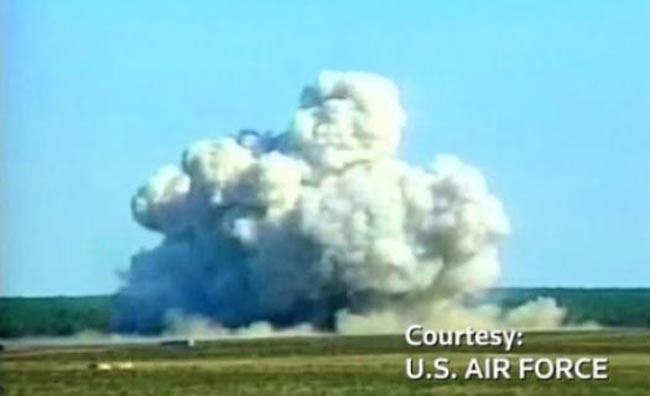“If you look at what’s happened over the last eight weeks and compare that really to what’s happened over the past eight years, you’ll see there’s a tremendous difference, tremendous difference,” the US President Donald Trump said after the military unleashed the giant bomb on a largely unpopulated region of the Afghan wilderness. “This was another very, very successful mission.”
The self-proclaimed Islamic State of Iraq and the Levant (ISIL) emerged relatively recently, surfacing about a year after the parent organization declared a caliphate in Iraq and Syria in 2014. Since then, it has staged deadly attacks on Afghan nation and stoked sectarian violence. Killing people on the grounds of their accidental backgrounds, the ISIL filled the air with a strong sense of fear. Since the ISIL’s ideology is far more perilous than the Taliban’s, the public initially feared that this group would play more deadly role. Little wonder this group showed the civilians, including women and children, no mercy and exercised its dogmatic beliefs harshly. The group’s barbarity in Syria and Iraq had already been heard and seen by the world, including Afghans.
With its emergence, the ISIL sought to sow the seed of ethnic tension among Afghans through targeting ethnic minority groups, mainly Shiite sect. Similarly, the group attacked the Shiite mourning proceedings at Ashura, and a shrine in Kabul – the casualties were mostly non-combatants. Although its sinister aim for triggering ethnic tension was proved abortive, it was a blow to democracy.
The escalated militancy also created a gap between the nation and state. The National Unity Government (NUG) was beset not only by the Taliban but also by the ISIL’s insurgency. In other words, the political turbulence was compounded by this emerging group, which heightened the graph of public mistrust and frustration and raised eyebrows. Hence, the NUG was engulfed in militancy from both sides namely the Taliban and the ISIL group. To sum up, on the one hand, the combat mission of NATO forces ended without the desired result and on the other hand, the ISIL group surfaced to destabilize the country.
Meanwhile, the peace negotiation with the Taliban elements came to a stalemate. The NUG called warring parties either to join peace process or will be treated militarily. Except for the Hezb-e-Islami Afghanistan (HIA), led by Gulbuddin Hekmatyar, all warring parties signaled negatively to Afghanistan’s peace offerings. The Kabul government adopted the right strategy in this regard i.e. called them opponent rather than “discontented brothers” and staged deadly and indiscriminate strikes against all militant fighters.
Following the US combat mission in Afghanistan, its advisory role continued. However, Donald Trump pledged to eradicate “Islamic terrorism” from the face of the Earth. Recently, the US army dropped its largest non-nuclear bomb in Afghanistan. Dubbed the “Mother of All Bombs”, the 9,797kg GBU-43 Massive Ordnance Air Blast (MOAB) was unleashed in combat for the first time on Thursday, April 13, engulfing a remote area of eastern Nangarhar province in a huge mushroom cloud and towering flames.
The Afghan Defense Ministry said three dozen fighters were killed in the attack, which used one of the largest non-nuclear bombs in the US arsenal, the GBU-43, against a network of tunnels and bunkers in the east.
Afghan President Ashraf Ghani’s office said in a statement the attack was a part of a joint operation by Afghan and international troops. “Afghan and foreign troops closely coordinated this operation and were extra cautious to avoid any civilian casualties,” he is cited as saying.
But former president Hamid Karzai condemned the use of the weapon on Afghan soil. “This is not the war on terror, but the inhuman and most brutal misuse of our country as testing ground for new and dangerous weapons,” he said on social media network Twitter.
In a statement Friday, the Taliban also condemned the strike, which it called a “show” by US forces that want to convince the world they are taking a strong stand against the ISIL group. The United States had “no justification” for using such a powerful bomb during combat, said the statement, which was distributed on the instant messaging app Viber.
According to the top US military commander in Afghanistan General John Nicholson, US forces conducted 79 “counterterror strikes” in March against ISIL group in Nangarhar, killing as many as 200 militants.
However, The United Nations has raised concerns that the American air campaign is swelling civilian casualties in Afghanistan. Last year, air strikes by international forces caused at least 127 civilian deaths and 108 injuries, up from 103 deaths and 67 injuries in 2015, the United Nations said.
The ISIL group, which is changing into a serious threat to Afghanistan, will have to be combated strongly and its hideouts are to be eradicated. However, the question is that will the ‘Mother of All Bombs’ slay the mother of (root out) ISIL group? The picture and news of this mammoth bomb have gone viral, however, the impact is not believed to be as huge as to eradicate any terrorist groups from the country or, at least, mitigate the militancy. Perhaps, it is a message of threat to warring factions, including the Taliban.
Home » Opinion » Will the ‘Mother of All Bombs’ Slay the Mother of ISIL Group?
Will the ‘Mother of All Bombs’ Slay the Mother of ISIL Group?
| Hujjatullah Zia

